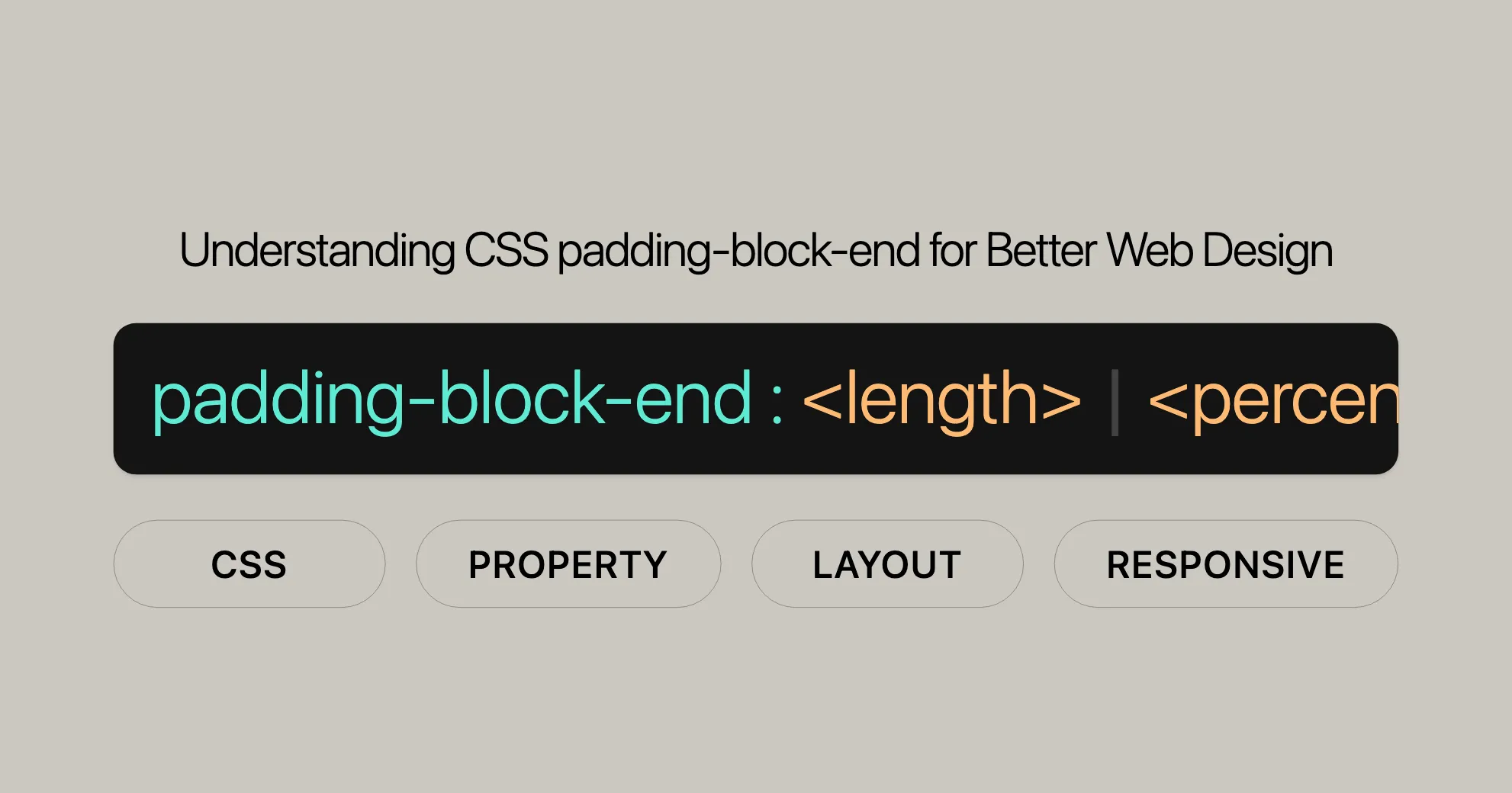- Services
- Case Studies
- Technologies
- NextJs development
- Flutter development
- NodeJs development
- ReactJs development
- About
- Contact
- Tools
- Blogs
- FAQ
Understanding CSS padding-block-end for Better Web Design
Use cases include responsive designs and varied text orientations.
Options available are length, percentage, and global CSS values.

Introduction
The padding-block-end property in CSS is a handy tool for web developers and designers. It lets you set the padding at the logical end of a block element, which can change based on the text’s direction and writing mode. This property became widely available in September 2021 and helps create flexible and responsive layouts, especially for multilingual sites.
Specification
The padding-block-end property is part of the CSS Logical Properties and Values Level 1 specification. This specification helps create more adaptable designs, especially in environments with different text orientations and writing modes.
Description
The padding-block-end property in CSS defines the padding at the logical end of a block element. Unlike traditional padding properties that use physical directions, padding-block-end adapts to the flow of text and layout. This makes it perfect for responsive and adaptable designs.
Syntax
padding-block-end: <length> | <percentage> | inherit | initial | revert | revert-layer | unset;- <length>: A fixed length value, like
px(pixels) orem(relative to text size). - <percentage>: A percentage of the inline size of the containing block.
- Global values: Common CSS values like
inherit,initial,revert,revert-layer, andunset.
Values
- <length>: A fixed length value (e.g.,
10px,1em). - <percentage>: A percentage of the inline size of the containing block (e.g.,
5%). - Global values:
inherit,initial,revert,revert-layer,unset.
Formal Definition
- Initial Value:
0 - Applies To: All elements except table-related elements
- Inherited: No
- Percentages: Relative to the logical width of the containing block
- Computed Value: As a
<length> - Animation Type: A length
Examples
Example 1: Setting Block End Padding for Horizontal Text
HTML:
<!DOCTYPE html><html><head> <title>CSS | padding-block-end Property</title> <style> h1 { color: green; } div { background-color: yellow; width: 110px; height: 80px; } .example { padding-block-end: 20px; background-color: purple; } </style></head><body> <center> <h1>Website</h1> <b>CSS | padding-block-end Property</b> <br><br> <div class="example">Example Text</div> </center></body></html>Example 2: Setting Block End Padding for Vertical Text
HTML:
<!DOCTYPE html><html><head> <title>CSS | padding-block-end Property</title> <style> h1 { color: green; } div { background-color: yellow; width: 110px; height: 80px; } .example { padding-block-end: 20px; writing-mode: vertical-lr; background-color: purple; } </style></head><body> <center> <h1>Website</h1> <b>CSS | padding-block-end Property</b> <br><br> <div class="example">Example Text</div> </center></body></html>Browser Compatibility
The padding-block-end property is supported by:
- Google Chrome 87
- Edge 87
- Firefox 41
- Opera 73
- Safari 12.1
See Also
For more information, check out:
- [CSS Logical Properties and Values]WebsiteUrl
- Mapped physical properties: [
padding-top]WebsiteUrl, [padding-right]WebsiteUrl, [padding-bottom]WebsiteUrl, [padding-left]WebsiteUrl - Related properties: [
writing-mode]WebsiteUrl, [direction]WebsiteUrl, [text-orientation]WebsiteUrl
Supported Browsers
The padding-block-end property is supported by:
- Google Chrome 87
- Edge 87
- Firefox 41
- Opera 73
- Safari 12.1
This wide compatibility ensures that your designs will work consistently across various platforms and devices, providing a seamless user experience. By using padding-block-end, you can create more flexible and adaptable web designs that cater to different text orientations and writing modes.
For the most up-to-date information on browser compatibility, you can refer to the [Browser Compatibility Data (BCD)]WebsiteUrl on MDN Web Docs. This resource provides detailed compatibility tables and allows you to verify the support for padding-block-end across different browser versions.
By leveraging the padding-block-end property, you can enhance the overall user experience and make your web content more accessible and visually appealing.
 สร้างเว็บไซต์ 1 เว็บ ต้องใช้งบเท่าไหร่? เจาะลึกทุกองค์ประกอบ website development cost อยากสร้างเว็บไซต์แต่ไม่มั่นใจในเรื่องของงบประมาณ อ่านสรุปเจาะลึกตั้งแต่ดีไซน์, ฟังก์ชัน และการดูแล พร้อมตัวอย่างงบจริงจาก Till it’s done ที่แผนชัด งบไม่บานปลายแน่นอน
สร้างเว็บไซต์ 1 เว็บ ต้องใช้งบเท่าไหร่? เจาะลึกทุกองค์ประกอบ website development cost อยากสร้างเว็บไซต์แต่ไม่มั่นใจในเรื่องของงบประมาณ อ่านสรุปเจาะลึกตั้งแต่ดีไซน์, ฟังก์ชัน และการดูแล พร้อมตัวอย่างงบจริงจาก Till it’s done ที่แผนชัด งบไม่บานปลายแน่นอน  Next.js สอน 14 ขั้นตอนเบื้องต้น: สร้างโปรเจกต์แรกใน 30 นาที เริ่มต้นกับ Next.js ใน 14 ขั้นตอนเพียงแค่ 30 นาที พร้อม SSR/SSG และ API Routes ด้วยตัวอย่างโค้ดง่าย ๆ อ่านต่อเพื่อสร้างโปรเจ็กต์แรกได้ทันทีที่นี่
Next.js สอน 14 ขั้นตอนเบื้องต้น: สร้างโปรเจกต์แรกใน 30 นาที เริ่มต้นกับ Next.js ใน 14 ขั้นตอนเพียงแค่ 30 นาที พร้อม SSR/SSG และ API Routes ด้วยตัวอย่างโค้ดง่าย ๆ อ่านต่อเพื่อสร้างโปรเจ็กต์แรกได้ทันทีที่นี่  วิธีสมัคร Apple Developer Account เพื่อนำแอปขึ้น App Store ทีละขั้นตอน อยากปล่อยแอปบน App Store ระดับโลก มาอ่านคู่มือสมัคร Apple Developer Account พร้อมเคล็ดลับ TestFlight และวิธีอัปโหลดที่ง่ายในบทความเดียวนี้ได้เลย
วิธีสมัคร Apple Developer Account เพื่อนำแอปขึ้น App Store ทีละขั้นตอน อยากปล่อยแอปบน App Store ระดับโลก มาอ่านคู่มือสมัคร Apple Developer Account พร้อมเคล็ดลับ TestFlight และวิธีอัปโหลดที่ง่ายในบทความเดียวนี้ได้เลย  TypeScript Interface คืออะไร? อธิบายพร้อมวิธีใช้และข้อแตกต่างจาก Type เรียนรู้วิธีใช้ TypeScript Interface เพื่อสร้างโครงสร้างข้อมูลที่ปลอดภัยและเข้าใจง่าย พร้อมเปรียบเทียบข้อดีข้อแตกต่างกับ Type ที่คุณต้องรู้ ถูกรวมเอาไว้ในบทความนี้แล้ว
TypeScript Interface คืออะไร? อธิบายพร้อมวิธีใช้และข้อแตกต่างจาก Type เรียนรู้วิธีใช้ TypeScript Interface เพื่อสร้างโครงสร้างข้อมูลที่ปลอดภัยและเข้าใจง่าย พร้อมเปรียบเทียบข้อดีข้อแตกต่างกับ Type ที่คุณต้องรู้ ถูกรวมเอาไว้ในบทความนี้แล้ว  Material-UI (MUI) คืออะไร อยากสร้าง UI สวยงามและเป็นมืออาชีพในเวลาอันรวดเร็วใช่ไหม มาทำความรู้จักกับ Material-UI (MUI) ที่ช่วยให้คุณพัฒนาแอปพลิเคชันบน React ได้ง่ายและดูดีในทุกอุปกรณ์
Material-UI (MUI) คืออะไร อยากสร้าง UI สวยงามและเป็นมืออาชีพในเวลาอันรวดเร็วใช่ไหม มาทำความรู้จักกับ Material-UI (MUI) ที่ช่วยให้คุณพัฒนาแอปพลิเคชันบน React ได้ง่ายและดูดีในทุกอุปกรณ์  เปรียบเทียบ 3 วิธีติดตั้ง install node js บน Ubuntu: NVM vs NodeSource vs Official Repo แบบไหนดีที่สุด? เรียนรู้วิธีติดตั้ง Node.js บน Ubuntu ด้วย NVM, NodeSource หรือ Official Repo เลือกวิธีที่เหมาะกับความต้องการของคุณ พร้อมเปรียบเทียบ เพื่อการพัฒนาที่มีประสิทธิภาพ!
เปรียบเทียบ 3 วิธีติดตั้ง install node js บน Ubuntu: NVM vs NodeSource vs Official Repo แบบไหนดีที่สุด? เรียนรู้วิธีติดตั้ง Node.js บน Ubuntu ด้วย NVM, NodeSource หรือ Official Repo เลือกวิธีที่เหมาะกับความต้องการของคุณ พร้อมเปรียบเทียบ เพื่อการพัฒนาที่มีประสิทธิภาพ! พูดคุยกับซีอีโอ
We'll be right here with you every step of the way.
We'll be here, prepared to commence this promising collaboration.
Whether you're curious about features, warranties, or shopping policies, we provide comprehensive answers to assist you.


